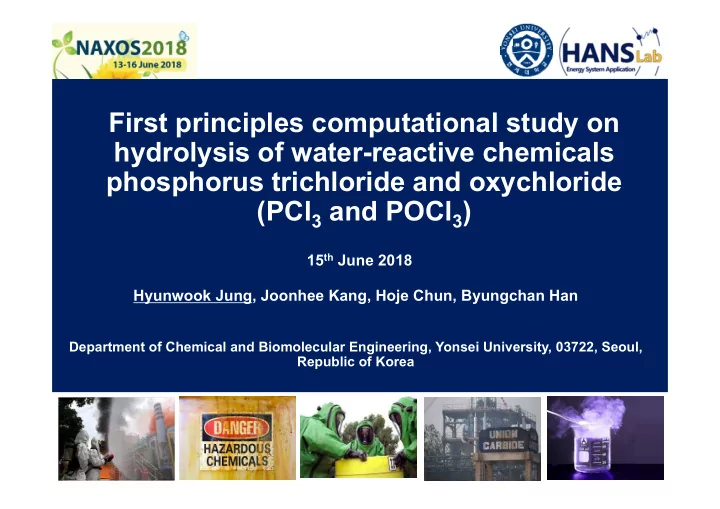

First principles computational study on hydrolysis of water-reactive chemicals phosphorus trichloride and oxychloride (PCl 3 and POCl 3 ) 15 th June 2018 Hyunwook Jung, Joonhee Kang, Hoje Chun, Byungchan Han Department of Chemical and Biomolecular Engineering, Yonsei University, 03722, Seoul, Republic of Korea
Motivation PCl 3 POCl 3 0 0 4 2 3 2 (Phosphorus Trichloride) (Phosphorus Oxychloride) ₩ ₩ • Chemical Properties • Chemical Properties - Colorless Liquid - Colorless Liquid - Density: 1.576g g/cm3 - Density: 1.576g g/cm3 - Vapour pressure: 100mmHg - Vapour pressure: 100mmHg • Common Uses • Common Uses Solar Cell Pesticides Flame Retardant N-type Dopant IC Optical Fiber Plastic Additives Chelating Agent World production of PCl 3 & POCl 3 exceeds more than 1/3 million tons annually They are essential chemicals in industry because of their versatile uses 2 Y. Segall et al. Chem. Res. Toxicol. 2003, 16, 350-356
Motivation Chemical disasters from unexpected reaction AZF Disaster (France) Tianjin Explosion (China) Death: 30 Deaths: 173 Cause: NH 4 NO 3 Cause: NaCN, NH 4 NO 3, … 2 Dec. 1984 27 Sep. 2012 12 Aug. 2015 21 Sep. 2001 Bhopal Disaster (India) Gumi HF leakage Death: at least 3787 (Korea) Cause: Methyl isocyanate Deaths: 5 Cause: HF Yet, reaction database is far from completeness, which hinders safe control of chemical accident 3
Motivation REACH Regulations in EU (Registration, Evaluation, Authorization, and Restriction of Chemicals) Experiments, Animal testing Physicochemical, Conventional approach Toxicological, Ecotoxicological Properties Computer Simulation, Ab-initio calculation Alternative approach Measurement methods of required physicochemical properties Experiment Ab-initio Calculation Reliable but, Not realistic in time, cost, Fast, low cost, and very safe. feasibility, and safety 4 Carlos Nieto-Draghi et al. 2015. Chem. Rev. 115 (24) 13093-13164
Outline 1. Motivation 2. Model Systems and Computational Details 3. Results and Discussion - Water-catalyzed hydrolysis - Structural analysis - Solvent effect by water and charge analysis - Potential energy surface profile 4. Summary 5. Acknowledgement 5
Model Systems and Computational Details Grotthuss Mechanism; three-fold role of water Reactant H 2 O water Solvent Catalyst PCl 3 Model Systems Calculated using: Gaussian09 B3LYP 6-31+g(d,p) 6
Water-Catalyzed Hydrolysis Free energy diagram PCl 3 (g) + 3H 2 O(g) → H 3 PO 3 (g) + 3HCl(g) POCl 3 (g) + 3H 2 O(g) → H 3 PO 4 (g) + 3HCl(g) Table 1 . Reaction heat for each steps of the hydrolysis and experimental data (in parenthesis) PCl 3 POCl 3 1 st step -5.88 -8.85 2 nd step -0.19 -9.84 3 rd step -3.98 -8.34 Tautomerization -3.67 - Δ H -13.73 (-15.44) -27.03 (-24.1) 7 H. Jung et al. Journal of Hazardous Materials 341 (2018) 457-463
Structural Analysis Torsional angle as key-descriptor of kinetics � C � C � PCl � � 90° See-saw jh1 � C � C � �� � 180° Trigonal bipyramidal Table 2. Torsional angle around central Phosphorus in the transition states PCl 3 POCl 3 Torsional Torsional Step Angle Angle High ∆� ‡ Low ∆� ‡ High ∆� ‡ Low ∆� ‡ 1 st Cl 1 Cl 2 PCl 3 150.26 ˚ 91.63 ˚ Cl 1 Cl 2 PO 157.87 ˚ 177.57 ˚ 2 nd Cl 1 Cl 2 PO 148.70 ˚ 91.16 ˚ O 1 ClPO 2 151.06 ˚ 167.66 ˚ 3 rd ClO 1 PO 2 146.33 ˚ 79.07 ˚ ClO 1 PO 2 150.96 ˚ 151.89 ˚ � ��° � ���° 8 H. Jung et al. Journal of Hazardous Materials 341 (2018) 457-463
Slide 8 sp3 -> sp3d state 로 전환된다는 내용을 좀더 잘 표현할 필요가 있음 . jh1 jung hyunwook; 12/6/2018
Solvent Effect by Water: Charge Analysis Charge Density Distribution Hybridization shift(sp 3 → sp 3 d) is qualitatively confirmed 9 H. Jung et al. Journal of Hazardous Materials 341 (2018) 457-463
Potential Energy Surface Profile ‡ ‡ ‡ PCl 3 +n·H 2 O POCl 3 +n·H 2 O PCl 2 (OH)+HCl POCl 2 (OH)+HCl Typical gas phase S N 2 reaction has double-well PES profile (PCl 3 ) POCl 3 has triple-well PES profile; Due to additional coordination by double bonded Oxygen 10 H. Jung et al. Journal of Hazardous Materials 341 (2018) 457-463
Summary Adjacent water molecules play key role as a catalyst toward hydrolysis reaction via proton transfer. Torsional angle around phosphorus atom is key-descriptor of the kinetics. Hybridization of phosphorus is shifted from sp 3 to sp 3 d at transition state. Activated complex with charge separation was more stabilized by water. PCl 3 and POCl 3 have different potential energy profile due to different coordination around phosphorus. 11 H. Jung et al. Journal of Hazardous Materials 341 (2018) 457-463
Acknowledgement This work was supported by • The Korea Ministry of Environment (MOE) as “the Chemical Accident Prevention Technology Development Project” • Global Frontier Program through the Global Frontier Hybrid Interface Materials (GFHIM) (2013- M3A6B1078882) • The Defense Industry Technology Center (DITC) for financial support from contract No.UC15000ID 12
Thank you for your attention!! Contact Info. Hyunwook Jung Email: jungsdao@gmail.com Phone: +82-10-2780-2396 13
Recommend
More recommend